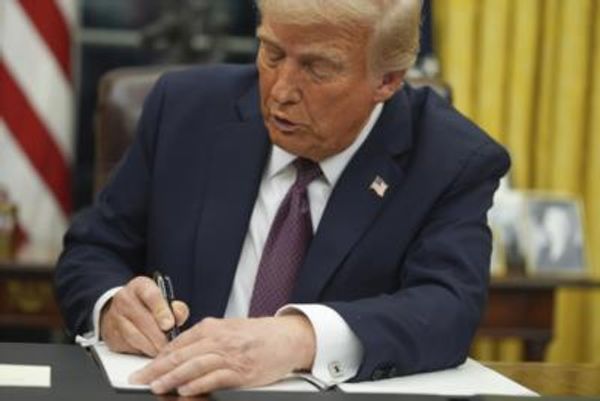
Jeff Koons fondly recalls when his toddler son Ludwig proudly presented him with a multi-colored mound of Play-Doh, announcing “Voilà!” That experience inspired a two-decades-long project that produced five unique versions of a massive polychromed aluminum sculpture that’s meticulously textured to resemble the popular modeling compound.
The monumental sculpture, comprising 27 precisely interlocking sections of painted aluminum, is a focal point of Jeff Koons: Lost in America on view at Qatar Museums’ Gallery ALRIWAQ through March 31, 2022. The American artist’s first exhibition in the Gulf region spans his vast and prolific oeuvre, navigating his own art historical terrain via Pop Art, Minimalism, and the readymade. The presentation in Doha, allowing viewers to examine every angle and crevice mimicking a child’s manipulation, is sure to reprise the jaw-dropping awe when it debuted in a retrospective at the Whitney Museum in 2014. Each of the five iterations has a different color variation, allowing gravity to keep it in place.
“Jeff was very taken by how his little kid went to him and said ‘Voilà!’ and (showed) him his little masterpiece. And the object grew in the imagination of Jeff and became this giant sculpture that took decades to realize,” curator Massimiliano Gioni said during a preview tour for global journalists last week, citing other examples of objects linked to childhood. “They are gifts. They are objects that you will encounter in the birthday party.”
While recognizable, the audacious Play-Doh hints at Abstraction when viewed more for its complexity of processes and presentation than representation. Imagine the sections of bold colors as layered brushstrokes on a large-scale canvas.
The exhibition title is borrowed from a 1985 American satirical comedy film of the same name directed by Albert Brooks, about a 1980s yuppie couple in Los Angeles who are disgruntled by their bourgeois lifestyle. Koons wants viewers to draw their own interpretations of that title, as well as the intention or meaning of the works.
“I'm trying to transcend. I'm trying to become a better human being, and what I hope is that my works communicate to people and disarm them, that they're able to look at something and feel comfortable with themselves to have a sense of self acceptance,” Koons said in a one-on-one interview at the gallery. “And when we're able to accept ourselves, then we're able to remove fear and interact with the world around us, and to be able to exercise the essence of our own potential. You don't have to bring anything to a work of art other than who you are that it's all about that.”

In the 1990s, the “conception” of works like Play-Doh (1994-2014) “was impossible to realize with the technology of the time,” said Gioni, an Italian curator and contemporary art critic based in New York City. Koons’ work references his suburban childhood in York, Pennsylvania, and he cites his father, a furniture dealer and interior decorator, as a primary influence and supporter of his creative endeavors. Henry Koons displayed his 9-year-old son’s copies of Old Master paintings in his shop window to engage passersby.

Childlike whimsy and youthful ambition set the mood when we’re greeted by a never-before publicly shown photo portrait, The New Jeff Koons (1980). The young artist poses directly at the camera with a box of large crayons, one in hand, foreshadowing his posturing throughout life. During a tour, Koons repeatedly speaks about the enduring impact of his childhood.
“'I’m four years old (in the portrait). That's kind of like the first time that I felt like an artist. I had no idea what art could be. I knew nothing about art history. I went to art school, and (after) my first art history lesson, I feel like I survived,” Koons recalled in the one-on-one interview. “People feel that they have to already know a certain amount of information about artists, certain movements, or certain theories. And instead of art being something that empowers you, it ends up disempowering. You never have to bring anything ever to any life experience level of art other than who you are at that moment. And it's always about that moment for me.”
The exhibition, featuring more than 60 works spanning 40 years, is designed to be viewed as a portrait of United States culture through the lens of Koons’s autobiography. The sweeping survey sprawls across 16 galleries, each with autobiographical text sharing Koons’ memories, influences, and enchantment with U.S. visual culture. While vast in scope and size, the autobiographical context creates an intimate narrative with the viewer. Viewers find themselves reflected in the mirrored surfaces of sculptures and paintings, inviting a limitless journey of visual engagement.

A dedicated family man, Koons was accompanied in Doha by his wife Justine Wheeler and their six children. Losing custody of Ludwig in a bitter divorce from his first wife and muse, adult-film star Ilona Staller, was profoundly devastating for Koons, who witnessed the transformative Play-Doh creation during a monthly visitation, said Gioni.
Viewing Koons in Doha recontextualizes our western gaze, exploring the perspective of a city where futuristic skyscrapers flawlessly and fantastically coexist with centuries-old tradition. The dichotomy of the culture underscores Koons’ ability to present simple-looking forms born from complicated techniques.
“Brilliantly curated by Massimiliano Gioni, Jeff Koons: Lost in America is an outstanding example of the bilateral connections and engaging dialogue we foster through the Years of Culture program,” said Her Excellency Sheikha Al Mayassa bint Hamad bin Khalifa Al Thani, Chairperson, Qatar Museums. “With this presentation, Qatar Museums fulfils its role as a beacon for the region, providing audiences in Doha with an opportunity to experience the distinctive worldview of this justly celebrated artist.”







